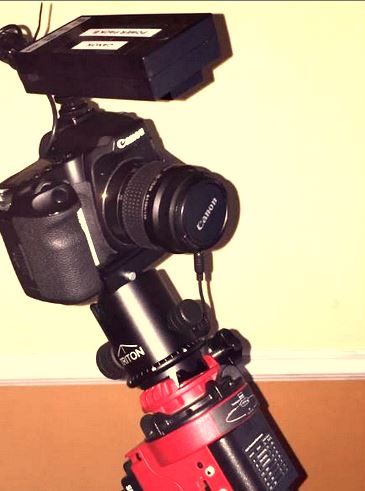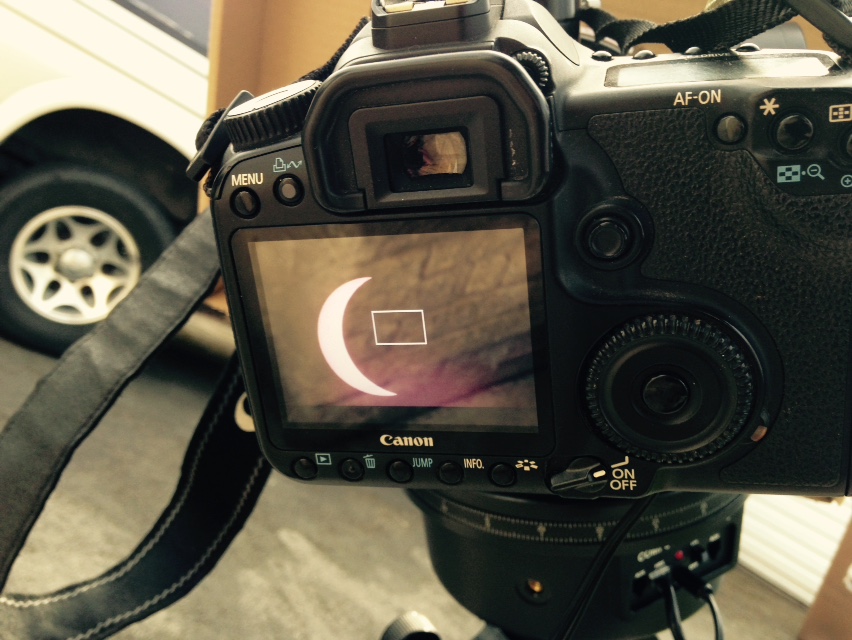Tuesday 29th April 2014 - Jupiter near Castor and Pollux
 Tuesday, April 29, 2014 at 7:32AM
Tuesday, April 29, 2014 at 7:32AM Jupiter is still an excellent object forming a triangle with Castor and Pollux as shown below
 [Your Name Here] | Comments Off |
[Your Name Here] | Comments Off |
Ford's excellent
monthly calendar
ABOUT THE WEBSITE - CLICK HERE
My Telescopes
My Main Telescope - C14 and Paramount ME

My new Paramount MyT and 8-inch Ritchey-Chretien Telescope

MyT Hand Controller
My Meade 12 inch SCT on a CGEM (Classic) Mount
My 4 inch Meade Refractor with Sky Watcher Guidescope and ZWO camera on a CGEM (Classic) Mount

Skywatcher Star Adventurer Mount with Canon 40D
My Solar setup using a DSLR and Mylar Filter on my ETX90

DSLR attached to ETX90. LiveView image of 2015 partial eclipse on Canon 40D
I try to log my observing and related activities in a regular blog - sometimes there will be a delay but I usually catch up. An index of all my blogs is on the main menu at the top of the page with daily, weekly or monthly views. My Twitter feed is below. I am also interested in photograping wildlife when I can and there is a menu option above to look at some of my images. I try to keep the news feeds from relevant astronomical sources up to date and you will need to scroll down to find these.
The Celestron 14 is mounted on a Paramount ME that I have been using for about 10 years now - you can see that it is mounted on a tripod so is a portable set up. I still manage to transport it on my own and set it all up even though I have just turned 70! It will run for hours centering galaxies in the 12 minute field even when tripod mounted.
 Tuesday, April 29, 2014 at 7:32AM
Tuesday, April 29, 2014 at 7:32AM Jupiter is still an excellent object forming a triangle with Castor and Pollux as shown below
 Monday, April 28, 2014 at 7:09AM
Monday, April 28, 2014 at 7:09AM This is the week ahead from Sky and Telescope
 Sunday, April 27, 2014 at 11:46AM
Sunday, April 27, 2014 at 11:46AM
In February 2012 I used the Bradford Robotic Telescope to take the following images.
 Saturday, April 26, 2014 at 7:05AM
Saturday, April 26, 2014 at 7:05AM I attended the Society for the History of Astronomy Spring Conference held in Chetham's Library in Manchester today. Note: All images from i-phone.
Dr. Michael Powell the Librarian at Chetham's had put a number of astronomical books from the library on display. This included the John Bevis "Atlas Celeste" which was discovered in the library of the Manchester Astronomical Society:
 Friday, April 25, 2014 at 7:02AM
Friday, April 25, 2014 at 7:02AM Separated from my telescopes by over 1000 miles with an empty dome and cloudy skies I looked at some of my old astronomy books in my study. Sir Robert Ball's book contained a number of images of domes and telescopes. Here are images from the book describing Dunsinck Observatory in Dublin.
Here is a description of Dunsink Observatory.
and details of the Grubb Refractor on Wikipedia
and a view of the interior
Sir Robert Ball refers to " ...the equatorial telescope , the object glass of which was presented to the Board of Trinity College, Dublin by the late Sir James South. The main part of the building is a cylindrical wall, on the top of which reposes a hemispheriacal roof. In this roof is a shutter, which can be opened so as to allow the observer in the interior to obtain a view of the heavens...... the two lenses which together form the object glass of the instrument are twelve inches in diameter, and the quality of the telescope mainly depends on the accuracy with which these lenses have been wrought. "
 Thursday, April 24, 2014 at 7:55AM
Thursday, April 24, 2014 at 7:55AM On 15th May 2012 I used the Harvard MicroObservatory Telescope in Arizona to image Cygnus X1 a strong X-Ray source in the Constellation of Cygnus near Eta Cygni. The Black Hole and its binary companion HD 226868 (a 9th mag supergiant ) are believed to have a rotation period of 5.6 days. Of course you cannot see the black hole only the companion. The radius of the Black Hole's event horizon is in the region of 28 km and the object lies at a distance of 8100 Light Years. There is considerable interstellar dust in this region which you can see as dark patchy regions in this image - in fact the companion star to Cygnus X1 has been reduced by 3.5 magnitudes by this dust.
Details of the image are given here:
The position of Eta Cygni is shown below
 Wednesday, April 23, 2014 at 9:00AM
Wednesday, April 23, 2014 at 9:00AM Another hot day with blue sky. I hope its like this in the UK tomorrow..... I am going back via Murcia Airport after a drive up the AP7 Toll Motorway - usually only see half a dozen cars during the hour and a half drive.
I was reading the article by Allan Chapman in the 2004 Yearbook of Astronomy and reading about the 1639 transit so I thought I would produce an animation of the event using The SkyX Software.
This is as it would appear from Lancashire on 4th December 1639. (In fact as this occurred before the calendar change from the Julian Calendar so would actually have been the 24th November then!)
In 1761 there was another Venus Transit shown below.
 Tuesday, April 22, 2014 at 9:00AM
Tuesday, April 22, 2014 at 9:00AM I have now disassembled the CGEM and 4 inch refractor and also the TAL1. I am back to the UK on Thursday then back here at the new location in June.
On Saturday I am at the meeting of the Society for the History of Astronomy in Manchester - it is being held in Chetham's Library which is the oldest lending library in the world. If you go to the website there is an online search facility. I put in "astronomy" as the key word and checked out the results. There are books going back to pre-1500 in the collection. Worth more research.
I came across this video describing the work of Andy Devey that I referred to on Day 65.
The accompanying text:
"A solar explorer who captured close-up snaps of the sun has had them featured on a NASA website.
Retired Andy Devey has been an amateur astronomer for about six years and said the peak of his stargazing was seeing his own photos of the sun published on the NASA space weather website.
Other sun shots he's taken have made the front cover of the British Astronomical year book for 2011.
Andy, 55, uses a host of telescopes and cameras to capture the images - and all from his back garden in Darton."
 Monday, April 21, 2014 at 7:14AM
Monday, April 21, 2014 at 7:14AM Visible tonight is the constellation of Cancer - not a very distinctive shape.
It does contain the star cluster M44 that I imaged recently.
The above image shows M44 taken with the Canon 40D and 38mm lens using the magnifier in APT.
The above image was taken on 15th March 2014 using the SBIG ST9XE and 4 inch refractor
The above image was taken with a remote telescope last year.
The constellation also contains the cluster M67 - below
and when solved
 Sunday, April 20, 2014 at 3:36PM
Sunday, April 20, 2014 at 3:36PM The Sky next week from Sky and Telescope
In the evening I had a call from Andy Devey who had spotted a large fire near Sorbas moving from the west towards the mountains. It was extremely windy in the direction of Cabrera which had been evacuated under similar circumstances on previous occasions. Following Andy's directions I went out - still on the phone to him - to see if I could spot it. Going though the arch at Cabrera I looked to the south west and could see a bright red cloud reflecting the fire. Andy confirmed that he could see the same red cloud from El Pinar de Bedar where he has a good view of the entire mountain range to his South and East. From Cabrera the fire had not reached the crest of the most distant hills - I could only see the reflected glow. A neighbour came out who had also spotted it. During the night I checked a couple of times - it seemed to be diminishing as seen from Cabrera.
David Jackson has blogged about it.
(Scroll down to April 20th to see the details on David's Blog about this fire - it is constantly updated.)
On one of my checks during the night I went up the hill to try and get a view of the fire - which I could not - and switched off my torch. The stars were bright with Mars brilliant over the "Onion Dome" a large house with a Moorish dome that dominates much of Cabrera. Street lights in Cabrera are carefully designed and are only on walkways with 9W bulbs I believe. There are very few of them leaving an excellent dark sky.